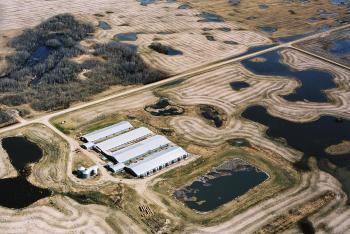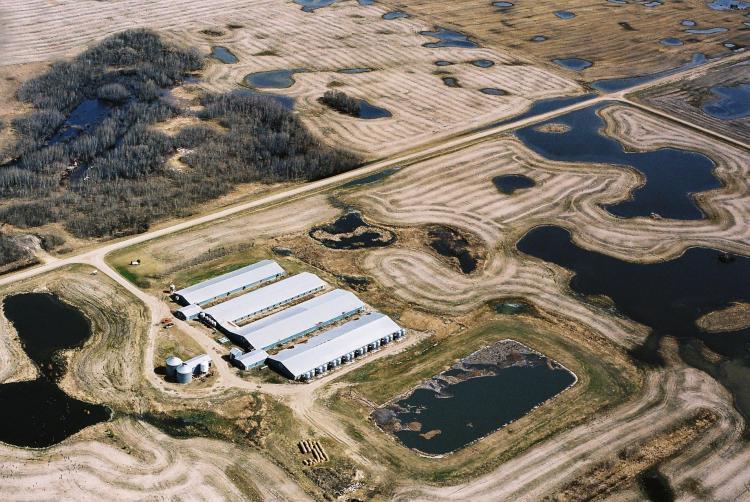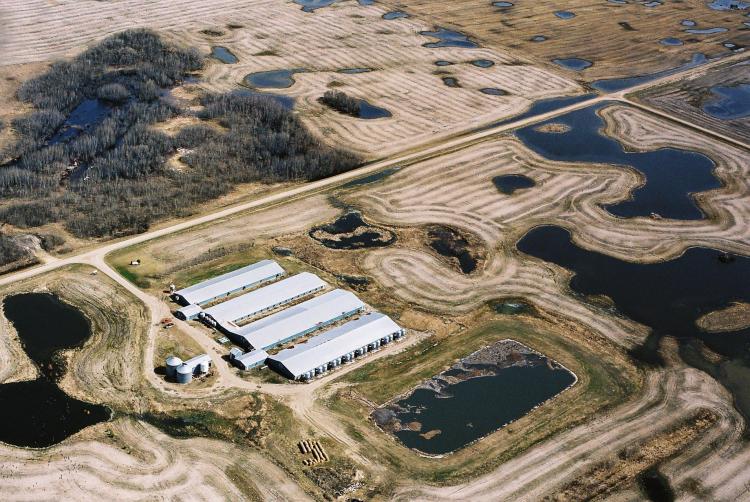Genetically engineered pigs developed at the University of Guelph have passed the first of several regulatory hurdles on the way to being approved for human consumption.
Environment Canada has determined that the university’s transgenic Yorkshire pigs—so-called Enviropigs—are in compliance with the Canadian Environmental Protection Act and can be produced outside of the research context in controlled facilities where they are segregated from other animals.
Developed in 1999, the Enviropig is the first transgenic animal created to solve an environmental problem—phosphorus pollution of surface and groundwater in areas of intensive pig production.
Depending on its age and diet, manure from the Enviropig contains 30 to 70 percent less phosphorus than that of regular pigs. Enviropigs are able to digest a form of phosphorus in feed grains that regular pigs cannot, producing manure that is less environmentally damaging.
Steven Liss, associate vice-president of research services at the University of Guelph, says researchers have been working to develop an animal that has “less of an impact environmentally and can be produced in a more sustainable fashion.”
“I think there’s a great deal among our community and population that would applaud efforts to reduce the environmental impact of animal production, and I think this would go a long way to increase the sustainability and lessen the footprint that pig production sometimes yields.”
Submissions have been made to Health Canada and other federal agencies including the U.S. Food and Drug Administration to have the pigs approved for human consumption and commercialization. Liss declined to speculate how long it could take the various agencies to reach a decision.
Currently, no country has approved products derived from genetically modified animals for human or animal consumption.
Lucy Sharratt, coordinator with the Canadian Biotechnology Action Network, doubts that Canadians are ready to embrace genetically engineered pork. She also questions whether Health Canada “has the tools to assess the safety of the Enviropig.”
“If the so-called Enviropig is commercialized, the first major concern is the safety of Canadians who are consuming products from those animals,” she said. “Health Canada does not have the trust of Canadians to approve this product or assess it for safety.”
Regarding the risk of contamination, Sharratt notes the recent crisis in the flax industry after genetically modified seeds entered the regular seed supply, causing the European Union—Canada’s largest flax market—to turn away shipments of Canadian flax. The EU has a zero-tolerance policy on genetically modified organisms.
The flax industry is currently scrambling to figure out how the so-called Triffid seed—developed by the University of Saskatchewan in the 1990s but ordered destroyed 10 years ago after farmers raised concerns that the EU would reject it—found its way into commercial crops.
In 2002, the University of Guelph had its own contamination incident in which the remains of 11 genetically engineered piglets were mistakenly sent to be rendered and wound up in feed for chickens and turkeys on Ontario farms.
After an investigation, Health Canada found that the security lapse posed no risk to either humans or poultry.
Cathy Holtslander, community organizer with Saskatchewan-based Beyond Factory Farming, says rather than risking the unknowns inherent in commercializing the Enviropig, a safer way to address the problem of phosphorus pollution would be to reduce the concentration of hog-confinement facilities and the numbers of animals in them.
“The problem isn’t with the pigs. The problem of hog operations polluting the water has to do with the whole industrialization scale that has been developed to raise hogs.”
Holtslander cites the current crisis in Canada’s hog sector in which the government is paying millions of dollars to help farmers exit the hog industry as an example of why commercializing the Enviropig may not be such a good idea.
“The model of high-intensity large-scale hog production hasn’t worked even from the point of view of profitability and survival of the hog industry,” she says. “So it’s a failed model, and introducing a genetically modified pig to a failed model is not going to be beneficial, it’s not going to solve that problem, and I really wonder about the impact.”
She adds that the Enviropig is “yet another in a long series of technological fixes . . . and what generally happens when you do this is you create another problem that requires another technological fix.”
According to the Canadian Food Inspection Agency (CFIA), new products such as the Enviropig are “subject to a rigorous, science-based review process” by Environment Canada, Health Canada, and the CFIA before being approved for use in food or feed or for release into the environment.
Should the product receive full regulatory approval in the future, “other essential considerations such as consumer and market acceptance have to be made before deciding if commercialization should proceed,” the agency said in a statement.
The U of G’s Enviropig research is funded by both government and industry, including Agriculture Canada and Ontario Pork.
Sharratt is critical of universities that use public money to develop genetically engineered technologies “without a mandate from the public.”
“One of the deep problems with genetic engineering is that there’s been no public consultation, and the spectre of the Enviropig signals the immediate need for public consultations on genetic engineering,” she says.
“Health Canada and Environment Canada should be responsible for actually consulting Canadians on the future of genetic engineering instead of pursuing a costly assessment of safety for a product that I don’t think Canadians will want at all and will in fact vehemently reject.”
Environment Canada has determined that the university’s transgenic Yorkshire pigs—so-called Enviropigs—are in compliance with the Canadian Environmental Protection Act and can be produced outside of the research context in controlled facilities where they are segregated from other animals.
Developed in 1999, the Enviropig is the first transgenic animal created to solve an environmental problem—phosphorus pollution of surface and groundwater in areas of intensive pig production.
Depending on its age and diet, manure from the Enviropig contains 30 to 70 percent less phosphorus than that of regular pigs. Enviropigs are able to digest a form of phosphorus in feed grains that regular pigs cannot, producing manure that is less environmentally damaging.
Steven Liss, associate vice-president of research services at the University of Guelph, says researchers have been working to develop an animal that has “less of an impact environmentally and can be produced in a more sustainable fashion.”
“I think there’s a great deal among our community and population that would applaud efforts to reduce the environmental impact of animal production, and I think this would go a long way to increase the sustainability and lessen the footprint that pig production sometimes yields.”
Submissions have been made to Health Canada and other federal agencies including the U.S. Food and Drug Administration to have the pigs approved for human consumption and commercialization. Liss declined to speculate how long it could take the various agencies to reach a decision.
Currently, no country has approved products derived from genetically modified animals for human or animal consumption.
Lucy Sharratt, coordinator with the Canadian Biotechnology Action Network, doubts that Canadians are ready to embrace genetically engineered pork. She also questions whether Health Canada “has the tools to assess the safety of the Enviropig.”
“If the so-called Enviropig is commercialized, the first major concern is the safety of Canadians who are consuming products from those animals,” she said. “Health Canada does not have the trust of Canadians to approve this product or assess it for safety.”
Regarding the risk of contamination, Sharratt notes the recent crisis in the flax industry after genetically modified seeds entered the regular seed supply, causing the European Union—Canada’s largest flax market—to turn away shipments of Canadian flax. The EU has a zero-tolerance policy on genetically modified organisms.
The flax industry is currently scrambling to figure out how the so-called Triffid seed—developed by the University of Saskatchewan in the 1990s but ordered destroyed 10 years ago after farmers raised concerns that the EU would reject it—found its way into commercial crops.
In 2002, the University of Guelph had its own contamination incident in which the remains of 11 genetically engineered piglets were mistakenly sent to be rendered and wound up in feed for chickens and turkeys on Ontario farms.
After an investigation, Health Canada found that the security lapse posed no risk to either humans or poultry.
Cathy Holtslander, community organizer with Saskatchewan-based Beyond Factory Farming, says rather than risking the unknowns inherent in commercializing the Enviropig, a safer way to address the problem of phosphorus pollution would be to reduce the concentration of hog-confinement facilities and the numbers of animals in them.
“The problem isn’t with the pigs. The problem of hog operations polluting the water has to do with the whole industrialization scale that has been developed to raise hogs.”
Holtslander cites the current crisis in Canada’s hog sector in which the government is paying millions of dollars to help farmers exit the hog industry as an example of why commercializing the Enviropig may not be such a good idea.
“The model of high-intensity large-scale hog production hasn’t worked even from the point of view of profitability and survival of the hog industry,” she says. “So it’s a failed model, and introducing a genetically modified pig to a failed model is not going to be beneficial, it’s not going to solve that problem, and I really wonder about the impact.”
She adds that the Enviropig is “yet another in a long series of technological fixes . . . and what generally happens when you do this is you create another problem that requires another technological fix.”
According to the Canadian Food Inspection Agency (CFIA), new products such as the Enviropig are “subject to a rigorous, science-based review process” by Environment Canada, Health Canada, and the CFIA before being approved for use in food or feed or for release into the environment.
Should the product receive full regulatory approval in the future, “other essential considerations such as consumer and market acceptance have to be made before deciding if commercialization should proceed,” the agency said in a statement.
The U of G’s Enviropig research is funded by both government and industry, including Agriculture Canada and Ontario Pork.
Sharratt is critical of universities that use public money to develop genetically engineered technologies “without a mandate from the public.”
“One of the deep problems with genetic engineering is that there’s been no public consultation, and the spectre of the Enviropig signals the immediate need for public consultations on genetic engineering,” she says.
“Health Canada and Environment Canada should be responsible for actually consulting Canadians on the future of genetic engineering instead of pursuing a costly assessment of safety for a product that I don’t think Canadians will want at all and will in fact vehemently reject.”







